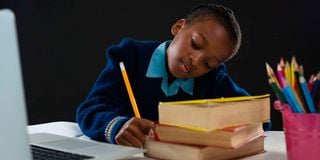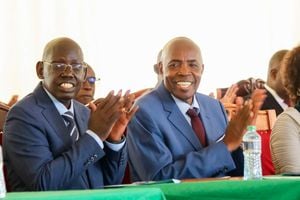
Learners will have fewer subjects and lessons per day following recent review of CBC.
The new academic year will herald numerous changes in schools including reduced subjects for learners after first review of the Competency-Based Curriculum (CBC), a shift in enrollment patterns and a surge in demand for teachers in Junior Secondary.
Universities are also expected to review their Bachelor of Education degree programme to align with CBC at secondary school level by the start of 2023/2024 academic year.
The first virtual public university in Kenya, the Open University in Kenya, which was awarded a charter by President Ruto in August last year, is also expected to operate in the new academic year .
Learners will have fewer subjects and lessons per day following recent review of CBC, which will lessen the burden on learners and parents as well as they will buy fewer textbooks.
This year, the Ministry of Education anticipates a shift in enrollment patterns.
Primary school enrollment is poised to decline significantly given the restructuring up to grade six.
Conversely, there's an expected uptick in JSS admissions as students move from grade eight to grade nine.
“In 2024, we anticipate a significant shift in primary school enrollment due to the restructuring up to grade six. Concurrently, there will be a notable increase in JSS admissions as students move from grade eight to grade nine. Additionally, with a streamlined curriculum featuring reduced subjects,” explained a head teacher of a primary school.
This shift in the number of students between the two levels will also mean more teachers for JSS.
The demand for JSS teachers which was projected at 73,000 by the end of last year, is expected to stabilise at 120,923 by this year, when the teachers recruited over time will constitute an optimum number for the level of education.
According to the projected staffing needs for the 23,274 primary schools, this year the number of teachers will reduce to 200, 542, down from 233, 965 last year.
“The reduction in the number of primary school teachers after 2022 is due to the adoption of the 2-6-3-3-3 structure, which reduces the number of years spent in primary schools from eight to six,” explains the report of the Presidential Working Party on Education Reform.
The teacher projections for JSS by subject areas in 2024 show English (14, 396), Mathematics (14, 396), pre-technical education (14, 396), Kiswahili (11, 517) and integrated science (11, 517) are the subjects that will account for the majority teachers.
The Ministry of Education recently streamlined the subjects for both lower and upper primary schools based on recommendations from the Presidential Working Party on Education Reform (PWPER).
The Kenya Institute of Curriculum Development (KICD) was advised to refine the curriculum's scope, focusing on subject integration, content redundancy, and overlaps across educational levels.
PWPER's recommendations specified that for Pre-Primary (PP1-PP2), the curriculum should encompass no more than five learning areas.
For Lower Primary (Grades 1-3), this number was capped at seven, and for Upper Primary (Grades 4-6), it was set at eight. Additionally, for Junior School (Grades 7-9), the limit was nine learning areas, while Senior School (Grades 10-12) should have no more than seven.
Acting upon these suggestions, the KICD, in collaboration with the Ministry of Education, rationalised the curriculum. For instance, in Pre-Primary, the five designated learning areas, each with specific weekly lessons, encompass Language Activities (5), Mathematical Activities (5), Creative Activities (6), Environmental Activities (5), and Religious Activities, along with the Pastoral/Religious Instruction Programme (1).
Furthermore, to enhance coherence, Agriculture and elements of Home Science merged into a unified subject titled "Agriculture and Nutrition," featuring four lessons weekly.
Transitioning to Lower Primary (Grades 1-3), the curriculum underwent reductions from nine to seven learning areas. This revision entails a decrease in weekly lessons from 35 to 31, inclusive of the Pastoral Programme of Instruction (PPI). Notably, Hygiene and Nutrition now fall under Environmental Activities, amounting to four lessons. Additionally, Creative Arts will encapsulate Art, Craft, Music, and Physical Education, spanning seven lessons.
Lower Primary (Grades 1-3) will cover Indigenous Language Activities (2), Kiswahili Language Activities, and Kenya Sign Language Activities (4), English Language Activities (5), Mathematical Activities (5), Religious Education Activities (3), Environmental Activities (4), Creative Activities (7), complemented by the Pastoral and Religious Instruction Programme (1).
“The new curriculum is commendable, especially considering the previous emphasis solely on arithmetic. By reducing the subject load, it alleviates the pressure on students. This approach is beneficial as it shifts away from an exam-centric model, prioritising skill development instead. The 8-4-4 system often led to student dropouts due to its demands. With this revised curriculum, the nation's literacy rates are poised to improve, given the renewed focus on skills rather than overwhelming students with numerous subjects,” said another teacher.
Another notable change in 2024 is the enhanced focus on Early Childhood Development Education (ECDE). For the first time, ECDE has received substantial funding, emphasising the foundational importance of these formative years in a child's educational journey.
“It marks a pivotal moment as the Early Childhood Development Education (ECDE) receives funding for the first time,” said one of the primary school head teachers.
The predicted 100 percent transition rate to Form One at the secondary level also raises concerns about potential congestion in classrooms and dormitories.
While releasing the 2022 Kenya Certificate of Primary Education (KCPE) exam results, Education Cabinet Secretary Ezekiel Machogu said all the 1,415,315 candidates who marked the conclusion of the 8-4-4 system after nearly four decades are set to transition to high school.
There is the push to increase free primary education capitation grant that currently stands at Sh1,420, per child per year, notwithstanding the high cost of living and the implementation of CBC.
The introduction of free day secondary schooling in 2008 also came with a capitation that currently stands at Sh22,244 per student per year to support tuition.
However, parents with learners in day and boarding schools incur the cost of meals, transport and accommodation.
Capitation and fees payable for boarding schools are based on the Ministry of Education’s fee guidelines as per school category, i.e., National, Extra-Country and County, with Category A boarding schools costing Sh75,798 annually out of which the Government provides Sh22,244, and parents contribute Sh53,554.
Category B boarding schools charge an annual fee of Sh62,779, with the Government paying Sh22,244 (schools receive Sh18,869), and parents provide Sh40,535.
There have been persistent protests about school principals violating these guidelines by imposing additional levies, grievances that surface at the beginning of each academic year.
Nonetheless, the spotlight is now on CBC, a dynamic approach designed to mould students into adaptable individuals armed with critical thinking and practical skills.
Historically, the 8-4-4 system, in place for years, has faced criticism for its rigidity, often prioritising rote memorization over holistic development. Recognising the evolving needs of the 21st-century learner, the country embraced the CBC in 2017, initiating its rollout in phases. Today, children across public institutions and the majority of private schools have been immersed in the curriculum since their primary education journey began.
According to the World Bank, since Kenya's inaugural comprehensive National Literacy Survey in 2006, literacy rates have surged from 61.5 percent among adults aged 15 and above to approximately 78.7 percent by 2014. Notably, there's been a significant uptick in female literacy rates, escalating from 30 percent in 1979 to 74.9 percent in 2015 as per U.S. government data.
However, recent educational metrics highlight areas of concern. The World Bank notes that in 2015, 70 percent of third-grade students couldn't read at a level expected for second-graders, a challenge more acute in rural settings. Additionally, in 2017, out of the 611,000 students who sat for their secondary school examinations, only 11.4 percent met the criteria for university admission.








